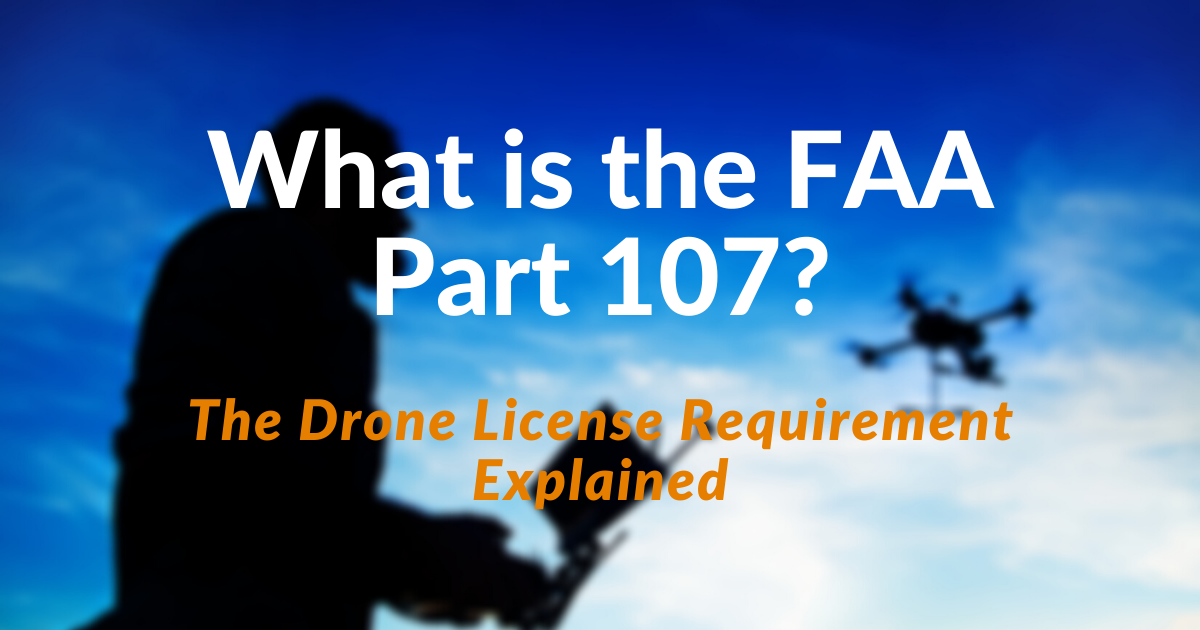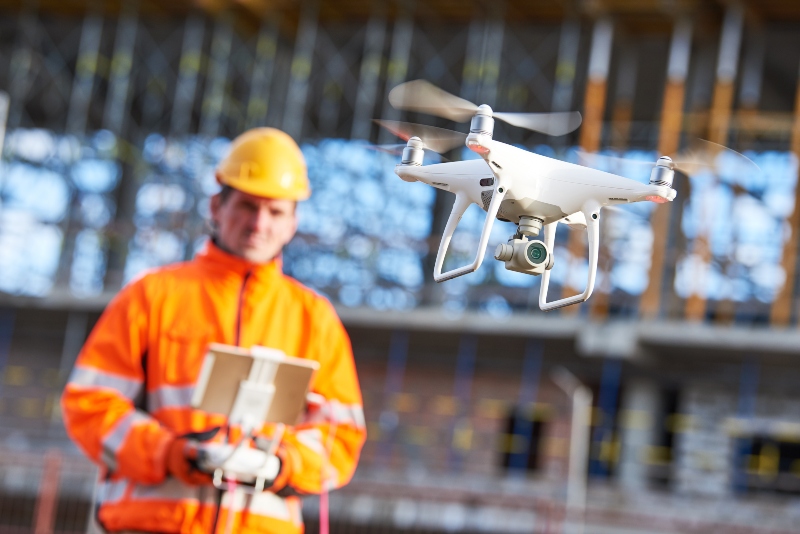What is the FAA Part 107? The Drone License Requirement Explained
BY Isabella Lee
12 December 2019The FAA Part 107 is a set of rules for operating a drone commercially (i.e. flying a drone to make money) in the U.S. It is also used to refer specifically to the certification drone pilots must have before they can legally offer professional drone services.

The Federal Aviation Administration (FAA) announced the Part 107 rules in June 2016. The ruling established requirements for commercial operators flying drones less than 55 pounds and is still effective today, albeit some changes have been made since it was first issued years ago.
If you want to become a professional drone pilot, familiarizing yourself with the FAA Part 107 is imperative, and this guide is a great place to start.
In this explanatory guide, you will learn about:
- What the FAA Part 107 allows you to do
- Where to take the FAA Part 107 test for your commercial drone license
- Study guides to help you pass the FAA Part 107 test
- How the FAA Part 107 has changed since it was first implemented
What Does The FAA Part 107 Allow Me to Do?
With an FAA Part 107 Certification, also known as a Remote Pilot Certification or commonly referred to as a “drone license,” you can legally make money with a drone. Your FAA Part 107 drone license allows you to sell your aerial drone photos and videos and to charge money for your drone services, like conducting aerial inspections, collecting aerial data, and surveying / mapping areas of land from an aerial perspective.
With a drone license and a registered drone, you can fly your drone at or below 400 feet within your line of sight during daylight or in twilight with anti-collision lighting. You should always yield the right of way to manned aircraft and get permission to fly in controlled airspace.

Do you really need to follow the FAA Part 107 rules? Yes! If you operate a drone for commercial purposes without a drone license or break one of the rules set forth in the FAA Part 107 ruling, the FAA can issue you a fine up to $27,500 for civil penalties and/or up to $250,000 for criminal penalties.
Read a summary of the Part 107 rules here (PDF).
The FAA has worked diligently to improve the waiver process so that you can do more as a licensed Part 107 drone pilot. In particular, we are seeing more waivers approved for operations beyond visual line of sight. The ability to fly beyond visual line of sight has been incredibly valuable for long-range drone operations such as pipeline inspections and agricultural crop surveys.
There are many areas of work you can seek out as an FAA-certified drone pilot. We go into detail about 10+ industries where drone adoption is growing in our Drone Jobs Guide.
Where to Take the FAA Part 107 Test for Your Commercial Drone License
You will take the FAA Part 107 test for your drone license at an FAA-approved knowledge testing center. You can locate the testing center nearest to you by visiting the PSI website. You will select ‘Unmanned Aircraft General – Small’ from the drop-down menu, and then you can locate a testing center by address, city, or zip.
If you already have a drone license and are testing for recertification purposes (required every two years), then you would select ‘Unmanned General – Recurrent’ from the list.
At most testing centers, the cost to take the FAA Part 107 test is $160.
The test consists of 60 multiple-choice questions, which you will be allotted two hours to complete. The minimum passing score is 70% (meaning, you’ll need to get at least 42 questions right).

You will get your results immediately to determine whether or not you passed. If you passed, the FAA will mail you a permanent remote pilot certificate within six to eight weeks.
Study Guides to Help You Pass the FAA Part 107 Test
You might be wondering how hard it is to pass the FAA Part 107 test. The test covers some fairly challenging topics like airspace map interpretation, radio communications procedures and micrometeorology. If you are new to aviation, these test materials can be pretty intimidating. The good news is that there are some high-quality resources available online to help you prepare for the test.
The FAA has a list of free PDFs you can use to study for the test, including a study guide and sample questions. However, some find the FAA’s resources too complicated for an aviation novice. They can be hard to navigate since they require a fair amount of time for digging up information and possible answers.
One of the most comprehensive ways you can study for the FAA Part 107 test is to enroll in a test prep course. We offer video-based lectures in our online FAA Part 107 test prep course — Drone Pilot Ground School — appropriate for aviation newbies and designed to fit multiple learning styles. The course includes full-length FAA Part 107 practice tests with real FAA questions.
We have helped over 30,000 drone pilots prepare for the Part 107 test and over 99% of our students report passing on the first try. Learn more about how to enroll in Drone Pilot Ground School and pass the FAA Part 107 test.

You can also check out our free FAA Part 107 study guides:
- The 13 Most Challenging Part 107 Test Prep Questions
- 6 Common Questions from Our Part 107 Test Prep Students
- How to Read a Sectional Chart
- Reading an Aviation Routine Weather (METAR) Report
How Has the FAA Part 107 Changed Since it Was First Implemented?
As we mentioned before, the FAA Part 107 ruling took effect in 2016. Since then, a few things have changed and more changes are anticipated in the future.
Here are a few things you should know about how the FAA Part 107 rules have changed since 2016:
Note: This is not a comprehensive list of all the initiatives and changes the FAA has implemented regarding the FAA Part 107. However, we’ve done our best to highlight the most important changes to date.
The FAA developed a digital system, LAANC, for authorizing drone pilots to fly in controlled airspace.
The nationwide rollout of LAANC (Low Altitude Authorization and Notification Capability) was completed in September 2018, allowing drone pilots to receive authorization to fly in controlled airspace in near real-time. Drone pilots can access LAANC through over 20 suppliers, such as AirMap and KittyHawk. Follow our step-by-step guide on how to use LAANC.
Prior to LAANC, the only way to get permission to fly in controlled airspace near an airport was to submit an airspace authorization request through the FAADroneZone, and wait up to 90 days. Now, for some operations, authorization can be granted in seconds.
The FAA announced details on the FAA Part 107 recertification process.
It was stated in the initial Part 107 ruling that drone pilots would have to renew their Remote Pilot Certificate every two years. However, it wasn’t until May 2018 that the FAA announced details about the recurrent test and re-certification process. The recurrent test is similar to the test you took when you first got certified, but the breakdown of topics is a bit different and there are fewer questions on the test (40 instead of 60).
The FAA modified its drone marking requirement.
In February 2019, the FAA updated its drone marking requirement. Drone owners are required to display the FAA-issued registration number on an outside surface of the aircraft. Owners and operators may no longer place or write registration numbers in an interior compartment due to concern that it could delay important action by first responders who need to identify the owner of the drone quickly.
The FAA added new locations to its list of restricted sites where drones are off-limits.
Since the Part 107 rules were issued, the FAA has used the authority granted it by Title 14 of the Code of Federal Regulations to establish further restrictions on where drones can be operated, in cooperation with various federal agencies such as the Department of the Interior (DOI), the Department of Energy (DOE), the Department of Justice (DOJ), and the Department of Homeland Security (DHS), among others. Some of the sites where these restrictions have been put in place are places like national monuments, prisons, and locations connected to national security, such as military bases and nuclear power facilities.
The FAA increased surveillance and began conducting ramp checks.
Due to an increase in the number of drone incidents being reported, the FAA announced in April 2019 that it would be increasing surveillance in areas where drone incident reports are high. Some sites identified for increased surveillance include communities near airports, areas with wildfire activity, and areas with ongoing emergency response efforts. This increased surveillance could lead to more ramp checks — a random spot check during which FAA officials from local FSDOs (Flight Standards District Offices) may inspect your drone or ask to see your drone license. Learn what you need to have on you in order to be prepared for a ramp check here.
Continued Reading: A Step-by-Step Guide to FAA Part 107 for U.S. Commercial Drone Pilots


